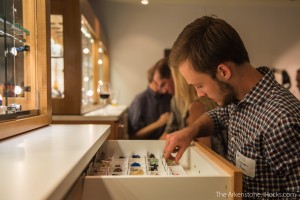Etiquette for Handling Fine Minerals and Crystals
If you are just starting your journey collecting minerals, we definitely recommend visiting collections to see a wide range of pieces in person. Some collectors will invite you to touch and handle pieces to observe all of its details. Having a chance to inspect and handle an exquisite piece can be exciting, but it can also make some people anxious or worried about mishandling and damaging a piece. To ease your worry, we wrote an introductory guide on how to properly handle minerals and fine stones.
Getting to know the collector
More often than not, a collector will walk you through on how to handle specific pieces of their collection. If they haven’t offered a walk-through, then ask them for advice on how to handle the piece.
It’s important to be well informed about how to handle the piece because certain minerals and stones are highly sensitive to pressure or change in temperature, resulting in damage.
If the collector offers you gloves, keep them on when handling the pieces unless told otherwise. Also, it is recommended that you remove all jewelry and wash your hands with a non-deodorized soap. Depending on their physiology, different minerals and stones have different reactions when exposed to sharp objects, oils and chemicals.
How to Handle Pieces
There are three main factors in the physiology of minerals and stones to consider when handling: hardness, tenacity, and porousness. These factors describe the structural integrity of a piece with some pieces being more complex to handle with care than others.
Hardness
Collectors use Moh’s scale of hardness to categorize specimens based on how resistant they are to being scratched. On Moh’s scale, Diamonds are considered highly resistant to scratches and are given a score of 10 out of 1 in hardness. Calcite, on the other hand, is considered “soft” with a score of 3 and can be scratched by a copper coin. Some minerals, like Gypsum, are soft enough to be scratched by a fingernail with a score of 2.
Most collectors are well informed about Moh’s scale of hardness and will gladly let you know if a piece is below a score of 4. It is recommended that these soft pieces are handled with great care in a soft lint free cloth to preserve their natural polish.
Tenacity
Tenacity is used to describe a number of behaviors of a mineral or stone under stress – brittleness, flexibility, elasticity, malleability, ductility, and sectility. In regards to handling, two behaviors to take into consideration are brittleness and flexibility.
Minerals and stones that are considered brittle are easy to break when struck along the grain. Like a piece of wood, the grain of a mineral is visible and signals the weakest point of a mineral or stone. Some gemstones that are exceptionally brittle along the grain are Fluoriate, Tiger’s Eye, and Imperial Topaz. To avoid adding stress to brittle pieces, hold them at the base and away from the grain lines.
Most minerals have a degree of flexibility, allowing them to take a blow easier than a gemstone. However, this doesn’t mean that the mineral will return to its original shape or position, like Antimony and Gypsum. It is recommended that observes don’t bend minerals because it can damage their fibers, resulting in a weaker mineral structure.
Porousness
If you’re planning to handle pieces for a long period of time, wearing nitrile or latex gloves is advised for more porous stones, such as Lapis, Lazuli, Jadeite, and Turquoise, because they are highly reactive to moisture and oils found in the human hand, though for quick examination, clean hands will suffice. When porous stones are exposed to moisture, they can become discolored, corroded, or striped of its natural shine.
Softer gems like Pearls and Amber are easily damaged by hairspray, cosmetics, or perfume. It is recommended that enthusiasts refrain from using these items when handling pieces.
Seeing a mineral and stone collection in person is a highly rewarding experience for any nature enthusiast. For more information about minerals, gems, and other fine stones and collections, read our other articles or browse iRocks!
